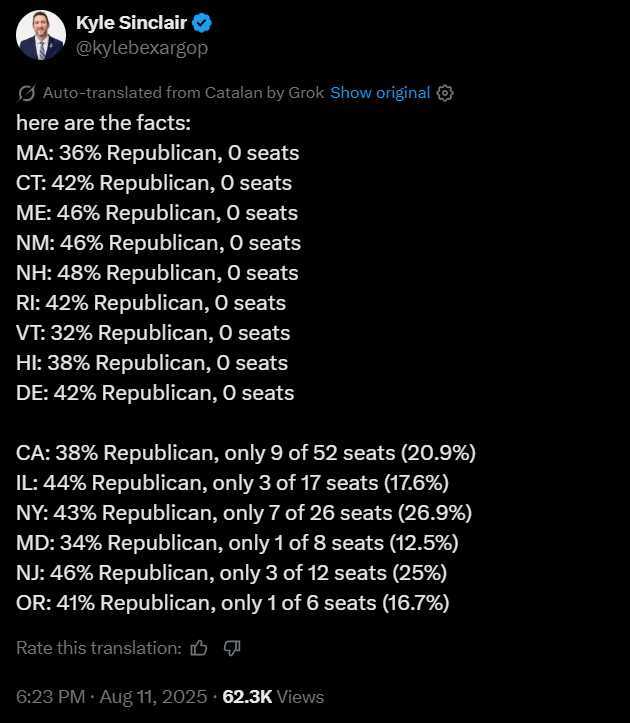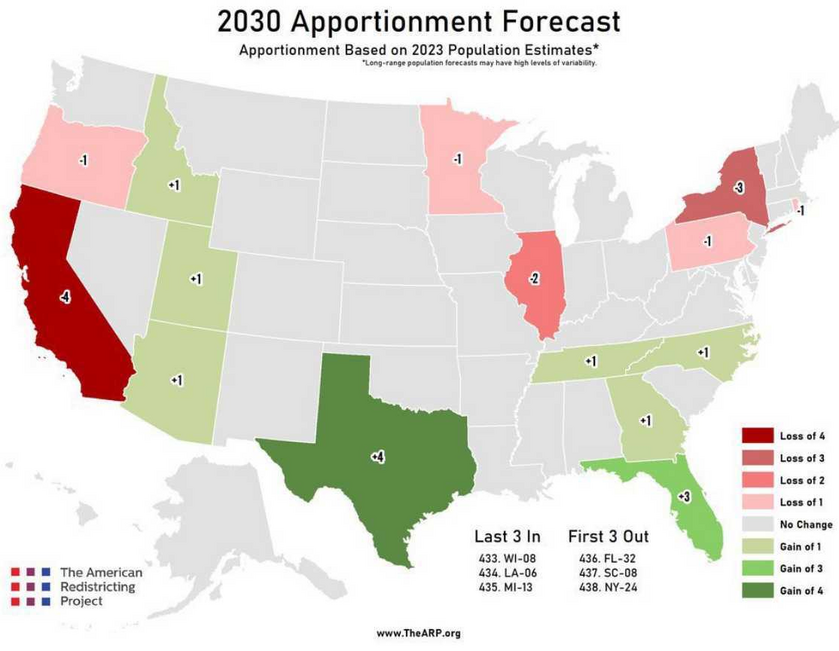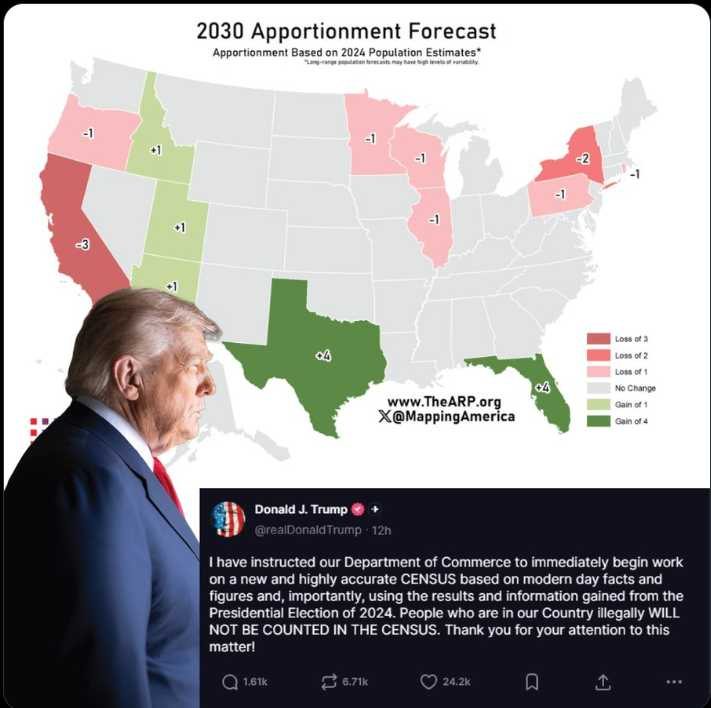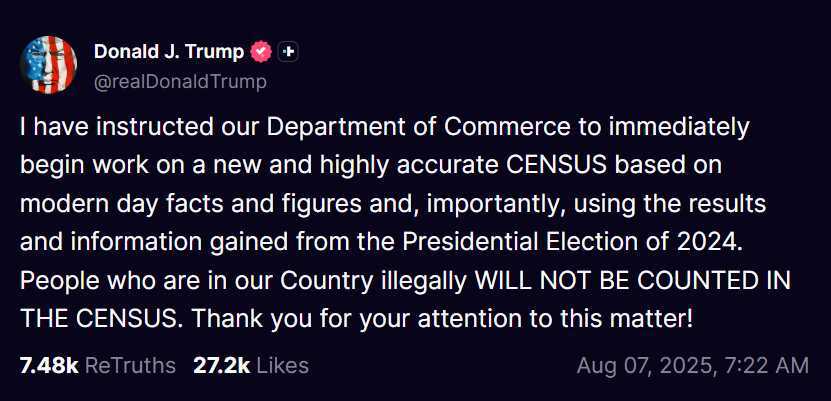America is standing at the edge of a political earthquake. It’s not just about one executive order, one census, or one round of redistricting. What’s unfolding is the culmination of decades of partisan maneuvering, demographic shifts, and constitutional disputes (and the results could permanently change the balance of power in Washington).
At the center of the storm is a startling admission: the U.S. Census Bureau overcounted several Democrat-leaning states in 2020, while undercounting Republican-leaning states. According to the Bureau’s own post-enumeration survey, these errors handed Democrats an estimated five extra congressional seats (and the electoral college votes that go with them) at the direct expense of red states like Florida and Texas.
Even more frustrating to many Americans, the Bureau insists the “oops” must stand until the next census numbers are applied in 2032. That’s nearly a decade of political power built on faulty data.
Trump’s Bold Countermove
President Donald J. Trump has decided that’s unacceptable. On August 7, 2025, he instructed the Commerce Department to conduct a new, highly accurate mid-decade census (one that excludes illegal aliens from the population count used for congressional apportionment and electoral college allocation).
Trump’s rationale rests on both constitutional and practical grounds. The Constitution requires an “actual Enumeration,” not statistical guesswork, and certainly not a count that inflates the representation of states with large populations of non-citizens. Under this new approach, red states like Texas and Florida could gain multiple seats, while blue strongholds like California, New York, and Illinois could see their delegations shrink.
Analysts estimate that excluding illegal aliens from the count could shift up to 14 seats from blue states to red states. California alone might lose four House seats. Florida and Texas could each gain four. The ripple effects on the Electoral College would be seismic, potentially locking Democrats out of a 270-vote path even if they won every “blue wall” state.
The Hypocrisy of Gerrymandering
While Democrats howl that this is an “attack on democracy,” they’ve long played the very same game in reverse. In fact, some of the most egregious gerrymanders in modern history exist in deep-blue states:
Massachusetts: Republicans make up 36% of voters but hold zero congressional seats.
Connecticut: 42% Republican, zero seats.
Maine: 46% Republican, zero seats.
New Mexico: 46% Republican, zero seats.
New Hampshire: 48% Republican, zero seats.
Rhode Island: 42% Republican, zero seats.
Vermont: 32% Republican, zero seats.
Hawaii: 38% Republican, zero seats.
Delaware: 42% Republican, zero seats.
Even in states where Republicans do hold seats, the imbalance is stark:
California: 38% Republican voters, but just 9 of 52 seats (20.9%).
Illinois: 44% Republican voters, but only 3 of 17 seats (17.6%).
Maryland: 34% Republican voters, but just 1 of 8 seats (12.5%).
Oregon: 41% Republican voters, but only 1 of 6 seats (16.7%).
This disparity is no accident. Blue states have systematically drawn maps to wipe out Republican representation. Now that red states are returning the favor, Democrats are discovering they have no room left to retaliate… they’ve already maxed out their own partisan advantages.
Texas as the Flashpoint
The battle has been especially fierce in Texas. After Democrat lawmakers fled the state to block legislation, Governor Greg Abbott and Attorney General Ken Paxton moved aggressively. Arrest warrants were issued for runaway legislators, and GOP lawmakers openly discussed increasing Republican representation with each week Democrats refused to return.
Under the Supreme Court’s 2019 Rucho v. Common Cause decision, partisan gerrymandering is a “political question” beyond federal court jurisdiction (meaning states can draw districts however they see fit). Red states are seizing that opportunity to counter decades of Democrat-drawn maps in blue territory.
The Bigger Picture
What’s happening now isn’t just about maps, or census methodology, or one executive order. It’s about a political realignment that could define American governance for a generation. By excluding non-citizens from the count and aggressively redrawing districts, Republicans could secure a structural advantage in both Congress and the Electoral College that Democrats would be hard-pressed to overcome.
Democrats have long argued these tactics undermine democracy. But as even some liberal commentators admit, they’ve been using the exact same tactics in their own states for years (and in many cases, more aggressively than Republicans ever did).
The irony is inescapable: the party that perfected the art of gerrymandering and census manipulation is now on the receiving end of its own playbook.
If the trends hold, the 2026 midterms could deliver a decisive shift in power… not just for the next Congress, but for decades to come.














